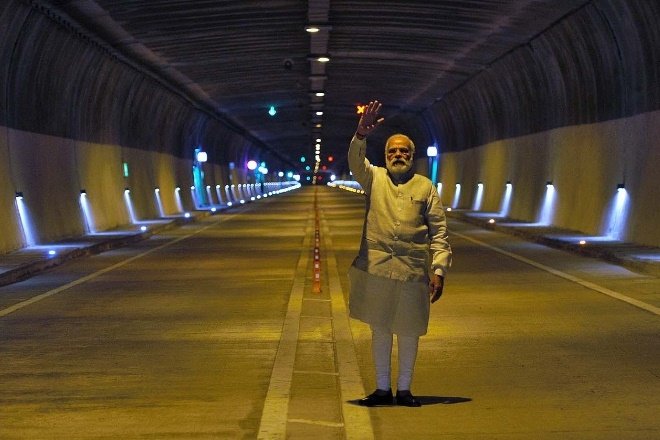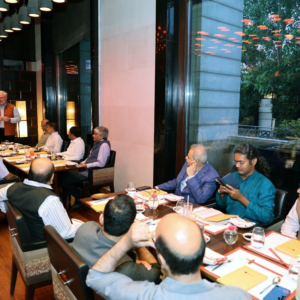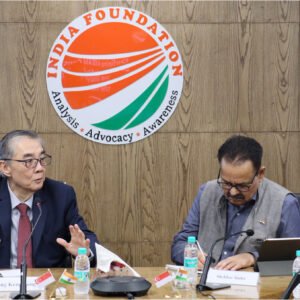Development of nations, advancement of societies and progress of mankind is often weighed quantitively through the parameters of infrastructural development. Be it the signs of globalisation or mapping governance priorities, the visual impacts are often in terms of buildings built, roads laid, operational airports, with contemporary indicators like pipeline network laid, digital connectivity infrastructure amongst many others.
As the Narendra Modi led government was sworn in for its second consecutive term in office in 2019, a clear emphasis amongst a multitude of priorities was on turning India into a USD 5 trillion economy. For India to achieve this goal, the key lies in re-aligning priorities and ensuring the development and governance of robust infrastructure. To ensure holistic and multi-sectoral development, India needs to ensure supply side reforms. Not just upgrading the existing facilities but creating new ones which will drive both the supply and domestic demand side of India’s development story.
As per an estimate, a global investment of USD 94 trillion is needed to meet the infrastructure requirement of the world between 2016 and 2040[i]. Of this, 50% of the requirement is in Asia. Major areas of investments are expected to be water and energy. It is to further this agenda that the Government of India under its National Infrastructure Pipeline has made a commitment to invest INR 100 lakh crore to develop infrastructure in the country.
The National Infrastructure Pipeline (NIP) is an ambitious whole-of-government project rolled out by the Government of India for fiscal 2019-25 to mobilise investments for infrastructural development in India. The project aims to capture the information of all projects (Brownfield, Greenfield, Under Development, Under Implementation or Under Conceptualisation) worth Rs 100 crore or more.
The first term of the NDA Government rode high on numbers in terms of expansion of road network, railway lines, upgrading existing infrastructure, development of ports, laying of pipelines for gas transmission, ensuring availability of cleaner fuel, electrifying the nation and expansion of airports. The second term so far has been more focussed on a qualitative upgradation and build-up of such facilities. The NIP, through its six priority areas, clearly defines the Government’s vision of an infra-structurally developed India of 2025.
TRANSPORT INFRASTRUCTURE
The bedrock of any nation’s progress lies in its network of connectivity. A nation progresses when it moves, and it moves when the country is connected internally through a network of accessible and robust network of roadways, railways, airways and waterways. Keeping in mind the idea of a New India, transportation sector has been one of the key sectors for priority development and investments for the NDA Government in its second term.
Roads
The pace of construction of roads touched an all-time high of 10,237 kms of highways constructed in 2019-20 alone[ii] with an ambitious target of increasing this to 12,000 kms a year. But constructing highways by itself is not enough. There is a need to develop feeder roads, ring roads, and arterial roads around these highways to ensure decongestion and last mile connectivity. In order to fill this gap, the Bharatmala Pariyojana was implemented by Government of India with the vision of constructing greater lengths of highway roads, upgrading the existing ones and bridging critical infrastructure gaps to ensure a more efficient and effective utilisation of resources. Under this programme, special attention is being paid towards ensuring connectivity with ports and loading docks, backward and tribal areas, areas with high economic activity, places of religious and tourist interests and connectivity with neighbouring countries, wherever applicable.
The programme, which is also the flagship programme of the Ministry of Road, Transport and Highways (MORTH), was approved in 2017 with an initial corpus of INR 5,35,000 crore and a target of upgrading/constructing 34,800 km of highways by 2022. As per official statistics, projects for about 13,000 km have already been awarded with 2,587 km worth of project under bidding and another 13,000 kms under feasibility study. In terms of its economic benefits, the programme under its various phases will focus more on creating affordable infrastructure following the principles of shortest distance green project development wherever applicable instead of redevelopment of brown field projects while creating 35 crore man days of employment.
Tapping of the potential unleashed by private sector participation has acted as an enabler in achieving the speed at which roadways have developed in the country. However, there is still scope for greater cooperation between the private and public players to ensure timely delivery of projects. Greater digitisation of services like use of FASTags for toll collection, use of artificial intelligence for surveillance and traffic management, etc, have ensured better compliance and easier governance in case of violations. Penetration of deeper technological innovations for improved safety is a pillar of the Government’s vision for the road sector in 2025.
Railways
Indian railways form the lifeline of India’s transportation sector with an operational track network of over 1,00,000 km and a daily passenger movement of about 1.1 million people[iii]. The upgradation of the railways under Modi 2.0 has essentially been based on three broad pillars: Development and upgradation of hard infrastructure, betterment of passenger amenities and adaptation of new technology to keep up with the pace of national development.
The development and enhancement of existing rail infrastructure has had multiple benefits. In 2019, Indian railways has reported zero passenger fatalities. This success comes in the backdrop of reforms like upgradation of 96% of the signalling equipment from primitive ones to modern ones, and electrification of a majority of broad-gauge rail routes with a target of electrifying the remaining 28,000 km by December 2023[iv]. Investments have also been channelised to upgrade locomotives, betterment of the condition of tracks and skilling of personnel.
The second aspect of development of rail infrastructure in India is the modernisation of passenger amenities. Railways under Modi 2.0 has received a digital push with greater use of technology in passenger services like rail ticket booking, rail enquiry and other such allied services. A major modernisation drive was undertaken to upgrade the existing railway stations and equip them with essential conveniences like lifts and escalators. Keeping with its commitment to make development eco-friendly and in line with Sustainable Development Goals (SDGs), the government introduced services of bio-toilets and solar panel installation for lighting the railway tracks.
To keep with the pace of development and ensuring that railways is not left behind plans have been put in place to ensure the development of Dedicated Freight Corridors (DFCs). The development of Eastern and Western DFCs is being looked at as a move towards reducing the logistics costs and thus in turn give a push to the Make in India campaign.
The sector however still faces its share of challenges with trains running at frequent delays because of overlapping in high density corridors. Though there has been a massive improvement in passenger amenities, these are still limited to a few special trains with a lot of scope for improvement. While national railway has started to see its share of good days, the suburban trains are still running at overcapacity and are in need for massive decongestion.
It is to meet these challenges, that the Government proposes to invest a sum of about 13.7 lakh crores over five years through the NIP towards building of the DFCs, high speed rails and making railways more reliable and safer. Private participation is also being encouraged with two stations of Gandhinagar and Habibganj being developed on PPP basis.
Airways
With an annual growth rate of over 10% since 2008-09, the Indian aviation market ranks as the fastest growing domestic aviation market in the world. It also ranks 9th globally in terms of civil aviation. As per an estimate by the Airports Authority of India, Indian airports will be handling a passenger movement of about 400 million by 2024-2025.
When the Narendra Modi led NDA Government took to helm of affairs there were a total of 65 operational airports in the country which has now increased to 125 operational airports. Under the Regional Connectivity Scheme – Ude Desh ka Aam Nagrik (RCS-UDAN) launched by the Government, 57 unserved/under-served airports have been operationalised with 347 new routes offered by 11 operators[v]. The newly added airports have cumulatively served over 6 million passengers and have received a viability gap funding in excess of INR 1000 crore.
Private potential too has been thoroughly tapped in the maintenance and operation of brownfield and greenfield airports across the country. The expertise of private players in passenger amenity facilitation and service provision has played a big role in ensuring a Compound Annual Growth Rate (CAGR) of 12.4% in the immediate 5 years preceding the covid era[vi].
In terms of fleet management the Indian aviation operators rank better than the average with over 70% of the fleet being on lease basis against a global average of about 50%. Additionally, civil aviation in India is being made more efficient by involving the Indian Air Force in route management of commercial flights to ensure efficient use of the airspace while charting shortest possible routes with lowest fuel consumption.
While the aviation sector has seen a healthy growth, It has its share of challenges. Many of the airports in India are still operating at over 100% of their capacity, leading to longer lean times in passenger management, manual surveillance leads to delays in boarding and thus the use of artificial intelligence (AI) is being proposed to de-clutter the boarding process.
Ports
Revival of the use of inland waterways for maritime transportation has been a priority area for the Narendra Modi led NDA Government since its first tryst with power in 2014. The Government has taken several steps to ensure the mainstreaming of maritime routes as preferred means of transportation for commercial and non-commercial purposes. As per an estimate by the Ministry of Ports, Shipping and Waterways of the Government of India, approximately 95% of the country’s trade by volume and 68% by value happens through waterways. With a long coastline of 7,517 km marked by 12 major and 200 non-major ports, the Indian shipping industry plays a crucial role in supporting domestic and foreign trade[vii].
In order to develop new ports and work on modernisation of the existing ones, the Indian government has rolled out the Sagarmala Project. Besides port building and modernisation, resources sanctioned for the project are being diverted towards enhancement in capacity utilisation. At present, most of the ports in India are operating with basic to minimal technological intervention and thus are plagued with operational inefficiencies like higher turnaround time and under-utilisation of capacity. The aim of the Sagarmala project is to ensure holistic development of shipping ports. Project feasibility studies have also been conducted to develop coastal industrial zones around busy ports to reduce logistics cost to the extent possible. Beginning from 2015, over 500 projects with a total estimated cost of INR 3.59 lakh crore have been identified for implementation by 2035[viii].
Apart from commercial exploitation of maritime trade routes, Sagarmala project also deploys resources for development of coastal tourism, lighthouse tourism, skill development and building of new technology centres. A phased and quick adaptation of technology in the shipping sector will lead to better capacity utilisation of the existing and upgraded infrastructure coupled with reduction in logistics costs. Under this ambitious program, the government aims to increase the port capacity utilisation to 65% of the total available capacity.
Energy Infrastructure
Amongst the various pillars on which the NDA government is envisioning India’s progress, energy security has been given a high priority. The Prime Minister aspires to create a self-reliant and energy surplus nation by 2025. Connecting the length and breadth of the country with accessible sources of power which are not just affordable but provide for generation of clean energy is a priority goal for the Government.
As per the statistics released by the Ministry of New and Renewable Energy, India has a total renewable energy production of 94.43 GW with a well-placed target of increasing this to 175 GW by 2022. Moving towards alternate sources of renewable energy production, the Government is also pitching natural gas to be the wonder fuel of the future. Plans are being laid out to increase the share of gas in the national energy consumption mix from 6% to 15% by 2030.
Infrastructural developments in terms of laying over 16,000 km of gas pipeline across the country and approval for an additional 16,000 are on the anvil. Bidding has successfully been concluded for the tenth round of City Gas Distribution Network (CGDN) which affects 70% of the country’s population across 53% of the total geographical areas. This will ensure the availability of clean energy in 229 Geographical areas (GAs) benefitting 400 districts in total[ix].
To fuel vehicles, infrastructure has been adequately upgraded with 1906 CNG stations functional across the country to fuel 35.17 lakh vehicles on Indian roads[x]. Apart from building up the gas infrastructure, milestones have been achieved in the exploration of oil and gas as well. The national kitty of solar energy too has expanded with 40.09 GW of the 94.43 GW of total renewable energy being solar in nature[xi].
At the policy level, important reforms like replacement of the production sharing contract Open Acreage Licensing Policy (OALP) with the revenue sharing contract Hydrocarbon Exploration and Licensing Policy (HELP) has been welcomed by the industry and is being seen as a big step towards attracting greater investments for future exploration and production opportunities. While great inroads have been made in the energy infrastructure under the NDA government lacunae still exist in better use of technology to minimise AT&C losses, smart metering and user management services.
Digital Infrastructure
Modi 1.0 kick started the sprint of digital upgradation of India with the roll out of its much celebrated ‘Digital India’ campaign. The campaign was aimed at making the most of technology by adopting various digital and technological tools to ensure ease of living for the common man. Successful attempts were made at digitising governance and doing away with unnecessary paper trails, large scale digitisation of records took place, banking was reformed with the opening of bank accounts for every Indian along with digital banking services and linking with Aadhar, subsidy refunds were changed to digital transaction to plug leakages.
The fruits of this mammoth digitisation exercise reaped benefits in the COVID era with the availability of JAM trinity ensuring Direct Benefit Transfer (DBT) payments under various central government and centrally sponsored schemes. A transaction of over INR 27,000 crore was made to 11.42 crore beneficiaries even when the whole nation was in a state of lockdown[xii]. A digitally connected India also ensured the availability of all essential services through various e-platforms during the unusual circumstances of the global pandemic. Availability of not just services but goods through e-commerce served the twin purposes of catering to both the demand and supply side of the equation.
In terms of hard digital infrastructure, India today boasts of 119 crore mobile subscribers, an internet penetration of 40%, 1 lakh gram panchayats connected through Bharat Net, 796 Digital Villages, 128.99 crore enrolments for Aadhar, over 4 crore financial transaction through Unified Payment Interface (UPI) and 4.69 crore digitally literate beneficiaries[xiii].
However, challenges for building a digitally connected New India still lie in terms of increasing the penetration of internet connectivity in the rural belt. The Government has set for itself a target of increasing this to 80% by 2025. A complete roll out of 5G network to ensure better adaptation towards emerging technologies like cloud computing, e-Healthcare, Internet of Things, advancing Fintech and artificial intelligence will further give a boost to an already accelerating Digital India program.
Conclusion
The Narendra Modi led NDA Government came to power for the first time in 2014, riding on the promise of ‘Development For All’. The second term too was won on the strong foundational development work done between 2014-2019. Continuing on its commitment of ensuring an infrastructurally advanced India, the first two years of Modi 2.0 were about delivering promises made.
Former President of India Dr APJ Abdul Kalam in his much-celebrated work ‘India 2020’ had laid a comprehensive vision of how the India of 2020 will look like. He was optimistic of India and Indians being more forward looking and closer to being a developed nation. His idea of an India of 2020 was that of a more self-reliant nation, not just economically but in terms of ensuring national security, technological superiority, agricultural productivity, energy availability, literacy, and higher standards of living for its people.
While India might still be a little farther away from Dr Kalam’s vision of an India in 2020, the government has shown steadfastness in its commitment to reach there. Self-reliance of various kinds is being ensured through targeted reforms under the Atmanirbhar Bharat program, rolled out to inject life in an economy crippled by the ensuing pandemic.
The government remains committed to its promise of good governance, by ensuring holistic development of the country across all sectors from education to health, space to agriculture, and social to commerce. However, challenges lie ahead not in envisioning this progress but in execution of the vision with equal coherence.
Author Brief Bio: Deeksha Goel is currently working as a Senior Research Fellow at India Foundation. Her research interests include studying the Geopolitics of Indian Ocean Region. Deeksha graduated as an Engineer specialising in Electronics and Communication and has an MBA in Finance.
[i] Global Infrastructure Outlook 2017
[ii]https://morth.nic.in/sites/default/files/Annual%20Report%20-%202021%20(English)_compressed.pdf
[iii] Data Source: Indian Railways
[iv]https://www.narendramodi.in/vikasyatra/articledetail/infra-for-growth/building-infrastructure-for-building-a-new-india-549939
[v] Data Source: Ministry of Civil Aviation, Government of India
[vi]http://164.100.47.194/Loksabha/Questions/QResult15.aspx?qref=24059&lsno=17
[vii]http://shipmin.gov.in/sites/default/files/Shipping%20Annual%20Report%20English_compressed.pdf
[viii]http://164.100.47.194/Loksabha/Questions/QResult15.aspx?qref=23963&lsno=17
[ix] Press Release: Distribution of Letter of Intent for 50 Geographical Areas under the 10thCGD Bidding Round”; Petroleum and Natural gas Regulatory Board, Ministry of Petroleum and Natural Gas; March 1, 2019
[x]https://evreporter.com/lng-for-heavy-commercial-vehicles/
[xi]https://mnre.gov.in/img/documents/uploads/file_f-1618481027521.pdf
[xii]https://www.nic.in/blogs/direct-benefit-transfer-a-blessing-during-the-time-of-pandemic/
[xiii] Data Source: Ministry of Electronics and Information Technology, Government of India




